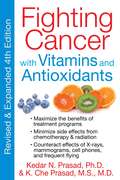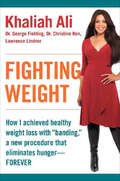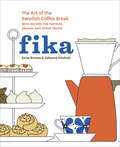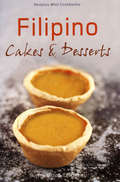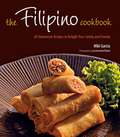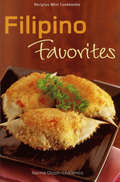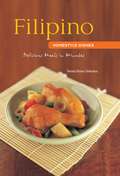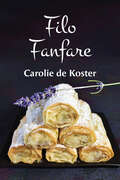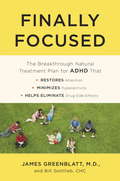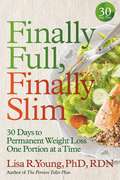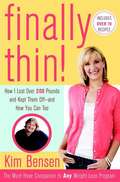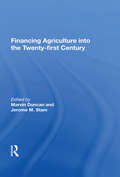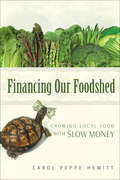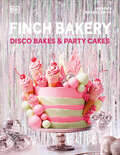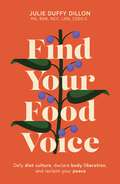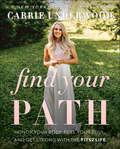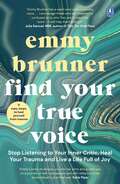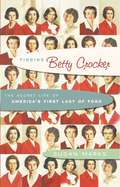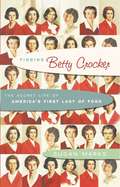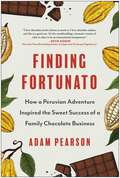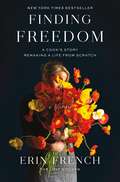- Table View
- List View
Fighting Cancer with Vitamins and Antioxidants
by K. Che Prasad Kedar N. PrasadThe most up-to-date and complete resource on the powerful benefits of micronutrients for cancer treatment and prevention • Written by the nation’s leading expert on vitamins and cancer research • Reveals how to maximize the benefits of your cancer treatment program while minimizing the side effects of chemotherapy and radiation • Shows how to counteract the carcinogenic effects of dental X-rays, CT scans, mammograms, cell phones, and other unavoidable hazards of modern life • Provides an easy-to-follow program of nutritional supplements to improve your odds of avoiding and beating cancer Despite extensive research and the development of new treatments and drugs, the U.S. mortality rate from cancer has not changed during the past several decades. Yet there are promising nutritional ways of avoiding and even beating cancer. In this completely revised and expanded edition, leading anticancer researcher Kedar N. Prasad and doctor K. Che Prasad reveal the latest revolutionary discoveries in the use of antioxidants and micro-nutrients to prevent and treat cancer--and also help with heart disease, Alzheimer’s, and Parkinson’s. Providing a simple nutritional program to follow, the authors show how micro-nutrients, vitamins, and antioxidants can enhance the beneficial effects of conventional cancer treatments, decrease their toxic side effects, improve long-term prognosis, and reduce the risk of new cancer. Explaining how antioxidants regulate gene expression and cancer heredity, the authors detail how to counteract the risks of dental and medical X-rays, CT scans, mammograms, cell phones, frequent flying, and other unavoidable hazards of modern life; reduce the oxidative stress of free radicals in the blood; and decrease chronic inflammation. Reviewing recent studies, they deflate the controversies surrounding the use of antioxidants in cancer treatment, revealing everything from the reason why many vitamins in foods are destroyed during storage to the surprising role of selenium in cancer prevention.
Fighting Weight: How I Achieved Healthy Weight Loss with "Banding," a New Procedure That Eliminates Hunger—Forever
by Lawrence Lindner Khaliah Ali Dr. George Fielding Dr. Christine RenKhaliah Ali, daughter of Muhammad Ali, shares her success at overcoming obesity through banding surgery—a minimally invasive, reversible, and extremely effective choice for drastically overweight peopleWhen Muhammad Ali's daughter Khaliah hit 325 pounds, she didn't need to be told again that she was morbidly obese. A lifetime of dieting, of starving, had not helped. Miserable, depressed, and unable to walk up a flight of stairs without losing her breath, she did not know which way to turn—until a friend pointed her toward a new type of surgery called gastric banding. It is just as effective as gastric bypass but with a fraction of potential complications. With the band placed around her stomach and completely taking away her hunger, Khaliah slimmed down to half her former size. Khaliah wraps her story of weight loss in this memoir of what it was like to grow up the daughter of one of the world's most famous men, and teams up with her surgeons at the New York University Medical Center to detail the lifetime of misery suffered by an obese girl; the ins and outs of the banding operation; and the joy, serenity, and health resulting from a solution that until now had eluded her.
Fika
by Anna Brones Johanna KindvallAn illustrated lifestyle cookbook on the Swedish tradition of fika--a twice-daily coffee break--including recipes for traditional baked goods, information and anecdotes about Swedish coffee culture, and the roots and modern incarnations of this cherished custom.Sweden is one of the world's top coffee consuming nations, and the twice-daily social coffee break known as fika is a cherished custom. Fika can be had alone or in groups, indoors or outdoors, while traveling or at home. A time to take a rest from work and chat with friends or colleagues over a cup and a sweet treat, fika reflects the Swedish ideal of slowing down to appreciate life's small joys. In this adorable illustrated cookbook, Anna Brones and Johanna Kindvall share nearly fifty classic recipes from their motherland--from cinnamon buns and ginger snaps to rhubarb cordial and rye bread--allowing all of us to enjoy this charming tradition regardless of where we live.From the Hardcover edition.d how we can all integrate its values into our daily lives.
Filipino Cakes and Desserts
by Norma Olizon-ChikiamcoThe Philippines has some of the tastiest treats in Asia and with this cookbook they can all be yours. Filipino Cakes and Desserts features easy recipes to make over 40 authentic and delicious sweets and treats that everyone will enjoy. Filipino Cakes and Desserts contains recipes for steamed, boiled, and chilled desserts, puddings, pies, pastries, and more. Recipes include: Mini custard flanBanana cream pieMango icebox cakePurple yam ice creamEgg tartsGlazed bananasFresh jackfruit in syrupHomemade avocado ice creamAnd many more! Also included in this book are unit conversion tables, dual unit measurements, an overview of the most essential Filipino dessert ingredients, and over 30 large clear photos. Each recipe includes cook time, prep time, and serving sizes. Enjoy!
Filipino Cookbook: 85 Homestyle Recipes to Delight Your Family and Friends
by Luca Invernizzi Tettoni Miki GarciaLearn authentic and delicious recipes with this beautifully illustrated Filipino cookbook.This delightful collection of 85 tried and tested recipes from the Philippines showcases the full range of authentic dishes from the country. Each region has its own distinct food culture and the book relates the secrets o=and soul of dishes that create the cultural mosaic that is the Philippines.The Filipino Cookbook features easy, step-by-step instructions that Filipinos and non-Filipinos alike will enjoy. Learn to make the famous vegetable dishes of the Tagalog peninsula to the seafood and noodles of the Visayan Islands and the spicy and colorful curries of Mindanao. Learn to make a perfect Pinakbet (Sauteed Vegetables with Shrimp Paste) or a delicious Halo-Halo (Mixed Fruits Dessert). Regale your friends with a wonderfully easy Paella (Rice and Seafood Medley) and Morcon (Stuffed Beef Roll) or an amazing bowl of Pininyahang Manok (Chicken with Pineapple).Utilizing readily available ingredients, The Filipino Cookbook allows the home cook to create authentic Filipino food at home, whether you are one of the 4 million Filipino-Americans living in the United States or simply interested in trying something new.Authentic Filipino recipes include:Pan de Sal Bread RollsWonton SoupCrispy Lechon PorkChicken AdoboSweet and Sour Fish
Filipino Favorites
by Norma Olizon-ChikiamcoThis book presents a collection of mouthwatering recipes from the Pearl of the Orient. Tuck into a delicious Paella, or savor the delicate flavors of Arroz a La Cubana (Cuban-style Rice). Those with a sweet tooth can indulge in Maja Blanca(Coconut Milk Pudding) or Halo Halo (Iced Fruit Mix) as after-meal accompaniments. Enjoy this lip-smacking selection of timeless recipes and sample some of the Philippines' most popular dishes!
Filipino Favorites
by Norma Olizon-ChikiamcoThis book presents a collection of mouthwatering recipes from the Pearl of the Orient. Tuck into a delicious Paella, or savor the delicate flavors of Arroz a La Cubana (Cuban-style Rice). Those with a sweet tooth can indulge in Maja Blanca(Coconut Milk Pudding) or Halo Halo (Iced Fruit Mix) as after-meal accompaniments. Enjoy this lip-smacking selection of timeless recipes and sample some of the Philippines' most popular dishes!
Filipino Homestyle Dishes
by Norma Olizon-ChikiamcoFilipino Homestyle Dishes offers the best of Filipino cuisine-more than 60 classic Filipino recipes as they are prepared in Filipino homes. From delightful snacks to delectable seafood, rice and noodle dishes, this wonderful collection of recipes present utterly delightful Filipino fare. Making these classic Filipino delights has never been easier-a quick trip to your local supermarket for some basic ingredients is all you need to enjoy these mouth-watering recipes. Clear recipes, step-by-step photographs and a glossary of ingredients ensure fantastic results every time!
Filipino Homestyle Dishes
by Norma Olizon-ChikiamcoFilipino Homestyle Dishes offers the best of Filipino cuisine-more than 60 classic Filipino recipes as they are prepared in Filipino homes. From delightful snacks to delectable seafood, rice and noodle dishes, this wonderful collection of recipes present utterly delightful Filipino fare. Making these classic Filipino delights has never been easier-a quick trip to your local supermarket for some basic ingredients is all you need to enjoy these mouth-watering recipes. Clear recipes, step-by-step photographs and a glossary of ingredients ensure fantastic results every time!
Filo Fanfare
by Carolie De KosterUnlock the secrets of filo pastry and discover a world of culinary delights. This authentic pastry, dating back to the 15th century, has a rich history that includes the famous baklava, a sweet treat created to commemorate the 40 days of Lent, with its 40 layers of thin, flaky pastry filled with nuts and spices, and soaked in syrup. From savoury appetizers to decadent desserts, filo pastry is a versatile ingredient that adds a touch of elegance to any dish. Whether you’re a seasoned baker or just starting out, this fully illustrated book will teach you how to work with filo pastry and create impressive dishes that will delight your senses. So why wait? Dive into the exciting world of filo pastry and start exploring its endless possibilities today!
Finally Focused: The Breakthrough Natural Treatment Plan for ADHD That Restores Attention, Minimizes Hyperactivity, and Helps Eliminate Drug Side Effects
by Bill Gottlieb James GreenblattDISCOVER THE ADHD SOLUTION FOR YOUR CHILDDr. James Greenblatt has seen thousands of children and adults struggling with the symptoms of ADHD – hyperactivity, inattentiveness, impulsiveness, and often irritability and combativeness. Rather than simply prescribing medication for their ADHD symptoms, he tailors remedies to his patients’ individual needs, detecting and treating the underlying causes of the disorder. Finally Focused provides proven natural and medical methods to easily treat problems such as nutritional deficiencies or excesses, dysbiosis (a microbial imbalance inside the body), sleeping difficulties, and food allergies, all of which surprisingly can cause or worsen the symptoms of ADHD. Using Dr. Greenblatt’s effective Plus-Minus Healing Plan, parents will first understand the reasons behind their child's symptoms, and then be able to eliminate them by addressing the child’s unique pattern of biological weakness. Adults with ADHD can do the same for themselves. And if conventional medication is still necessary, this integrative approach will minimize or even eliminate troublesome side effects. Using Dr. Greenblatt’s expert advice, millions of children and adults with ADHD finally will get the help they need to achieve true wellness.
Finally Full, Finally Slim: 30 Days to Permanent Weight Loss One Portion at a Time
by Lisa R. YoungWe're surrounded by food portions we've been led to believe are normal-64-ounce sodas, personal pizzas large enough to feed several people, and steaks and pastas that fill an entire plate. No wonder obesity rates in America have reached an all-time high. We eat oversize portions, gain weight, and try the latest fad diet, which only adds to our confusion about how to lose weight. Nutritionist and portion-size expert Dr. Lisa R. Young says the solution is simple: Eat foods you love in reasonable portions, and you will lose your excess weight and keep it off for good.Finally Full, Finally Slim shows you how to permanently lose weight by right-sizing your portions without eliminating entire food groups or staring at an empty plate. Within these pages, Dr. Young outlines thirty days' worth of simple changes to help you shed pounds and provides a portion plan that ensures you will feel satisfied. She expertly describes the relevance of diet to health and steers you toward whole foods and away from clever marketing claims that may be secretly sabotaging your weight-loss efforts. You'll learn useful strategies for how to eat out, enjoy special occasions, and indulge in a favorite treat without tipping the scale. And because weight loss is about more than food, Dr. Young addresses the whole person-your mind-set, environment, habits, and life-through research-based advice. You'll learn how relationships, gratitude, self-compassion, and sleep patterns, for instance, can make a difference. Portion control outlives all fad diets because it isn't a diet. It's a lifestyle.
Finally Thin! How I Lost Over 200 Pounds and Kept Them Off-- And How You Can Too
by Kim BensenBensen recounts how she lost more than 200 pounds, and then breaks down her success into a 10-step system that readers can follow. From choosing the right diet to the keys to keeping the weight off, this book covers it all in an upbeat, inspirational, and approachable tone.
Financing Agriculture Into The Twenty-first Century
by Marvin DuncanThis volume is concerned with the paradigm shifts occurring in U.S. agriculture and its related financial services sector. The U.S. agricultural sector is undergoing rapid change with large segments commonly described as industrialized. Often observers focus on the technological and structural changes that the sector is undergoing and ignore other
Financing Our Foodshed: Growing Local Food with Slow Money
by Carol Peppe Hewitt“[Hewitt] paints an engaging portrait of a community learning how to take care of its own, and offers inspiration for others looking to do the same.” —Amy Cortese, author of LocavestingIn towns and cities across North America, a quiet revolution is underway. Fed up with sending their money off to make a fast buck in faraway markets, people are putting their money to work where they live, in markets they trust and understand—starting with food.Financing Our Foodshed is a collection of real-life stories of these Slow Money pioneers and the local food entrepreneurs—sustainable farmers, bakers, restaurateurs, and more—they have chosen to support.Fueled by their desire to do more than just eat local food, lenders of “nurture capital” are making low-interest, peer-to-peer loans to the people who produce, process, distribute and sell local food. Meet these passionate food entrepreneurs like:Abi, talented artist-turned-baker, who borrowed the funds to start a gluten-free bakeryAngelina, owner of a Greek local foods restaurant, who refinanced exorbitant credit card debt incurred by renovationsChatham Marketplace, a much-loved grocery co-op whose monthly loan payments were reduced by a third, thanks to an ambitious collaboration between 16 investorsFinancing Our Foodshed tells the compelling stories of ordinary people doing something extraordinary, and will appeal to anyone who understands the critical importance of sustainably grown local food and resilient local economies, and wants a blueprint to get us there.“For anyone seriously interested in boosting his or her community’s economy—including politicians, policymakers, financiers, businesspeople, and activists—this book is essential reading.” —Michael H. Shuman, author of Put Your Money Where Your Life Is
Finch Bakery Disco Bakes and Party Cakes
by Lauren FinchWelcome to the wonderful world of Finch Bakery!Lauren and Rachel Finch, founders of Finch Bakery, share their best-kept secrets to decorating all-out celebration cakes and let you in on their top baking techniques to create indulgent brownies and cupcakes, decadent macarons, stuffed cookies of every kind, and your very own versions of their indulgent signature cake jars.Packed with crowd-pleasing classics and desserts to impress, this bestselling baking book has the treat to satisfy every sweet tooth, every time:- Over 80 Instagram-ready baking recipes- 15 step-by-step baking technique tutorials for beginners- Mix-and-match your favorite flavor combinations for sponges, fillings, buttercream, and toppings to build your own creationsThis gorgeous baking book is an unashamed celebration of sugar!Discover the hidden secrets to show-stopping bakes from tempering chocolate and leveling cakes, to crumb coating, piping, and scraping techniques. You'll learn the basics of cake decorating and baking before exploring indulgent flavor combinations.Recipes are designed to be standalone, but some also work in a build-a-block way so you can make your own creation by swapping the sponge, filling, sauce, or topping to satisfy your sweet tooth. With inventive creations and essential techniques, this is a whole new world of cake.A Sunday Times BestsellerThe Finch Bakery is your guide to creating mouth-watering homemade treats that are a success every time! This baking book includes a wide range of delightful treats that you can make at home. Explore delicious cupcakes, scones, cookies, cake balls, cake jars, traybakes, no-bake cakes, and celebration cakes. Get creative with classic recipes like lemon drizzle, decadent cookie cups, and Nutella everything - there is something for everyone!A showstopper in the kitchen, and on your coffee table, The Finch Bakery book is the ultimate baking gift for teenagers and adults alike. Get ready to show off your best baking achievements with the help of the Finch Bakers.
Finch Bakery: Sweet Homemade Treats and Showstopper Celebration Cakes
by Lauren Finch Rachel FinchWelcome to the wonderful world of Finch Bakery!Lauren and Rachel Finch, founders of Finch Bakery, share their best-kept secrets to decorating all-out celebration cakes and let you in on their top baking techniques to create indulgent brownies and cupcakes, decadent macarons, stuffed cookies of every kind, and your very own versions of their indulgent signature cake jars.Packed with crowd-pleasing classics and desserts to impress, this bestselling baking book has the treat to satisfy every sweet tooth, every time:- Over 80 Instagram-ready baking recipes- 15 step-by-step baking technique tutorials for beginners- Mix-and-match your favorite flavor combinations for sponges, fillings, buttercream, and toppings to build your own creationsThis gorgeous baking book is an unashamed celebration of sugar!Discover the hidden secrets to show-stopping bakes from tempering chocolate and leveling cakes, to crumb coating, piping, and scraping techniques. You'll learn the basics of cake decorating and baking before exploring indulgent flavor combinations.Recipes are designed to be standalone, but some also work in a build-a-block way so you can make your own creation by swapping the sponge, filling, sauce, or topping to satisfy your sweet tooth. With inventive creations and essential techniques, this is a whole new world of cake.A Sunday Times BestsellerThe Finch Bakery is your guide to creating mouth-watering homemade treats that are a success every time! This baking book includes a wide range of delightful treats that you can make at home. Explore delicious cupcakes, scones, cookies, cake balls, cake jars, traybakes, no-bake cakes, and celebration cakes. Get creative with classic recipes like lemon drizzle, decadent cookie cups, and Nutella everything - there is something for everyone!A showstopper in the kitchen, and on your coffee table, The Finch Bakery book is the ultimate baking gift for teenagers and adults alike. Get ready to show off your best baking achievements with the help of the Finch Bakers.
Find Your Food Voice: Defy diet culture, declare body liberation, and reclaim your peace
by Julie Duffy DillonConsider, what if diets are the problem, not me? By uncovering the real villain-the Seductive 'I-Should-Eat' Script-you will begin to remove years of shame and blame. You haven't been doing it wrong-systemic oppressions operating within the diet industry have scammed all of us into believing there is one way to eat to promote health. Diets push aside the well-known fact that sexism, racism, anti-fat bias, homophobia, and other systems of oppression impact the body and the person navigating the world within it. With this book, ditch common cookie cutter approaches rolled up with toxic positivity, expose the lies that society feeds us, and rewrite your rules around food, eating and your body.If you're at diet rock bottom, and want a way out, this book is for you.
Find Your Food Voice: Defy diet culture, declare body liberation, and reclaim your peace
by Julie Duffy DillonConsider, what if diets are the problem, not me? By uncovering the real villain-the Seductive 'I-Should-Eat' Script-you will begin to remove years of shame and blame. You haven't been doing it wrong-systemic oppressions operating within the diet industry have scammed all of us into believing there is one way to eat to promote health. Diets push aside the well-known fact that sexism, racism, anti-fat bias, homophobia, and other systems of oppression impact the body and the person navigating the world within it. With this book, ditch common cookie cutter approaches rolled up with toxic positivity, expose the lies that society feeds us, and rewrite your rules around food, eating and your body.If you're at diet rock bottom, and want a way out, this book is for you.
Find Your Path: Honor Your Body, Fuel Your Soul, and Get Strong with the Fit52 Life
by Carrie UnderwoodCarrie Underwood's instant New York Times bestseller on honoring your body, fueling your soul, and getting strong—a great gift idea for fans of fitness and the megastar country singer."I want to be healthy and fit 52 weeks of the year, but that doesn't mean I have to be perfect every day. This philosophy is a year-round common-sense approach to health and fitness that involves doing your best most of the time—and by that I don't mean being naughty for three days and good for four. I mean doing your absolute best most of the time during every week, 52 weeks of the year."—Carrie UnderwoodCarrie Underwood believes that fitness is a lifelong journey. She wasn’t born with the toned arms and strong legs that fans know her for. Like all of us, she has to work hard every day to look the way that she does! In FIND YOUR PATH she shares her secrets with readers, with the ultimate goal of being the strongest version of themselves, and looking as good as they feel. Carrie’s book will share secrets for fitting diet and exercise into a packed routine—she’s not only a multi-Platinum singer, she’s a businesswoman and busy mom with two young children. Based on her own active lifestyle, diet, and workouts, FIND YOUR PATH is packed with meal plans, recipes, weekly workout programs, and guidelines for keeping a weekly food and workout journal. It also introduces readers to Carrie's signature Fit52 workout, which involves a deck of cards and exercises that can be done at home—and it sets her fans on a path to sustainable health and fitness for life. Fit52 begins with embracing the "Pleasure Principle" in eating, making healthy swaps in your favorite recipes, and embracing a long view approach to health—so that a cheat a day won't derail you.Throughout the book, Carrie shares her personal journey towards optimal health, from her passion for sports as a kid, to the pressure to look perfect and fit the mold as she launched her career after winning American Idol, to eventually discovering the importance of balance and the meaning of true health. For Carrie, being fit isn't about crash diets or a workout routine that you're going to dread. It’s about healthy choices and simple meals that you can put together from the ingredients in your local grocery store, and making the time, every day, to move, to love your body, and to be the best version of yourself.
Find Your True Voice: Stop Listening to Your Inner Critic, Heal Your Trauma and Live a Life Full of Joy
by Emmy BrunnerEmmy redefines trauma in a way that allows you to accept the things that have happened to you in your life, reflect on who they've made you become & guide you on how to unravel yourself from the throws of these traumas. She gently enables you to go on and live with vibrant possibility ? Paloma Faith, Multi-platinum Singer & Songwriter__________Do you find yourself plagued by anxiety or depression? Do you struggle with an eating disorder or constantly criticise the way you look? Do you often feel stuck in destructive patterns/cycles and toxic relationships with partners/family/friends/colleagues? Do you feel like you play small and have lost touch with the real you? If you said yes to any of these then Find Your True Voice was written for you.Trained psychotherapist, Emmy Brunner, has created the ultimate 11-step self-healing guide you need to identify and overcome the wounds of the past that are negatively impacting your mental health and preventing you from being the happiest version of yourself. She will help you to: Identify your inner critical voice and challenge limiting beliefs Identify your personal unresolved trauma and shame/guilt you are carrying Find new, positive coping strategies Recognise and articulate your needs Confront and overcome fear, worry and anxiety Discover self-acceptance and begin to show up fully in all your relationships and your career Uncover your true purpose and reconnect with your passions/desires Using a combination of case studies, practical clinical advice and personal experiences, this book is guaranteed to help you take your first steps towards a more joyful, fulfilling life. Whether you're struggling with a lack of confidence, clarity and connection, or feel like all you can do is manage your mental health condition, Emmy Brunner is here to help guide you through the process of healing; cultivating a more compassionate relationship with yourself and creating the life you have always wanted.__________'Emmy's book envelopes you into her arms and guides you on a journey of self-compassion and self-reflection in an extraordinarily practical way' Katie Piper, Writer, Activist and TV Presenter
Finding Betty Crocker
by Susan MarksIN 1945, FORTUNE MAGAZINE named Betty Crocker the second most popular American woman, right behind Eleanor Roosevelt, and dubbed Betty America's First Lady of Food. Not bad for a gal who never actually existed. "Born" in 1921 in Minneapolis, Minnesota, to proud corporate parents, Betty Crocker has grown, over eight decades, into one of the most successful branding campaigns the world has ever known. Now, at long last, she has her own biography. Finding Betty Crocker draws on six years of research plus an unprecedented look into the General Mills archives to reveal how a fictitious spokesperson was enthusiastically welcomed into kitchens and shopping carts across the nation. The Washburn Crosby Company (one of the forerunners to General Mills) chose the cheery all-American "Betty" as a first name and paired it with Crocker, after William Crocker, a well-loved company director. Betty was to be the newest member of the Home Service Department, where she would be a "friend" to consumers in search of advice on baking -- and, in an unexpected twist, their personal lives. Soon Betty Crocker had her own national radio show, which, during the Great Depression and World War II, broadcast money-saving recipes, rationing tips, and messages of hope. Over 700,000 women joined Betty's wartime Home Legion program, while more than one million women -- and men -- registered for the Betty Crocker Cooking School of the Air during its twenty-seven-year run. At the height of Betty Crocker's popularity in the 1940s, she received as many as four to five thousand letters daily, care of General Mills. When her first full-scale cookbook, Betty Crocker's Picture Cook Book, or "Big Red," as it is affectionately known, was released in 1950, first-year sales rivaled those of the Bible. Today, over two hundred products bear her name, along with thousands of recipe booklets and cookbooks, an interactive website, and a newspaper column. What is it about Betty? In answering the question of why everyone was buying what she was selling, author Susan Marks offers an entertaining, charming, and utterly unique look -- through words and images -- at an American icon situated between profound symbolism and classic kitchen kitsch.
Finding Betty Crocker: The Secret Life of America's First Lady of Food
by Susan MarksIn 1945, Betty Crocker was bested only by Eleanor Roosevelt as the best-known woman in America. Originally published in hardcover by Simon and Schuster in 2005, this edition traces Betty Crocker's story from her "birth" in 1921, evolving brand persona, test kitchens, and connection to generations of American women in the context of societal trends. Marks, director of the documentary film The Betty Mystique, includes recipes and period illustrations. Annotation ©2007 Book News, Inc. , Portland, OR (booknews. com)
Finding Fortunato: How a Peruvian Adventure Inspired the Sweet Success of a Family Chocolate Business
by Adam PearsonEmbark on an up-close and personal journey into the northern Peruvian jungle as last-chance entrepreneurs accidentally stumble upon a variety of cacao thought to be extinct, in this chocolate-rich business adventure memoir. Take a front row seat to a family of entrepreneurs searching relentlessly for a sustainable competitive advantage in the wake of many failed attempts at starting a family business. When they inadvertently discover the legendary Nacional white cacao bean in a remote canyon of the Peruvian jungle, the USDA calls it &“an unprecedented discovery.&” The cacao is so rare that even acclaimed author and travel host Anthony Bourdain and chef Eric Ripert trek to this particular jungle to film a segment for Bourdain's "Parts Unknown." With no job and no other way to earn a living, the author&’s brother, Brian, moves to the jungle to live with cacao farmers—and Fortunato Chocolate is born. The family soon realize that their chocolate dream will only work if they reconceive and disrupt the supply chain. Instead of middlemen hoarding profits and keeping farmers in relentless poverty, they trade directly with them and produce what the BBC hails as "the Rolex of chocolate." Follow along as these intrepid entrepreneurs endure many heartbreaking near-victories and nail-biting adventures, ultimately shaking off failure and finding their competitive advantage in the humble white cacao bean and their ethical direct trade with the bean&’s farmers. Finding Fortunato is an inspiring and improbable tale that's infused with the indomitable entrepreneurial spirit, and revels in the gut instincts that lead to unimaginable success.
Finding Freedom: A Cook's Story; Remaking a Life from Scratch
by Erin French**New York Times Bestseller**From Erin French, owner of the critically acclaimed The Lost Kitchen, a TIME world dining destination, a life-affirming memoir about survival, renewal, and finding a community to lift her upLong before The Lost Kitchen became a world dining destination with every seating filled the day the reservation book opens each spring, Erin French was a girl roaming barefoot on a 25-acre farm, a teenager falling in love with food while working the line at her dad’s diner and a young woman finding her calling as a professional chef at her tiny restaurant tucked into a 19th century mill. This singular memoir—a classic American story—invites readers to Erin's corner of her beloved Maine to share the real person behind the “girl from Freedom” fairytale, and the not-so-picture-perfect struggles that have taken every ounce of her strength to overcome, and that make Erin’s life triumphant. In Finding Freedom, Erin opens up to the challenges, stumbles, and victories that have led her to the exact place she was ever meant to be, telling stories of multiple rock-bottoms, of darkness and anxiety, of survival as a jobless single mother, of pills that promised release but delivered addiction, of a man who seemed to offer salvation but in the end ripped away her very sense of self. And of the beautiful son who was her guiding light as she slowly rebuilt her personal and culinary life around the solace she found in food—as a source of comfort, a sense of place, as a way of bringing goodness into the world. Erin’s experiences with deep loss and abiding hope, told with both honesty and humor, will resonate with women everywhere who are determined to find their voices, create community, grow stronger and discover their best-selves despite seemingly impossible odds. Set against the backdrop of rural Maine and its lushly intense, bountiful seasons, Erin reveals the passion and courage needed to invent oneself anew, and the poignant, timeless connections between food and generosity, renewal and freedom.
